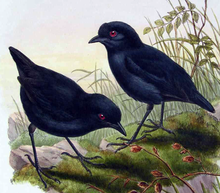Melampittidae
| Melampitta | |
|---|---|
 |
|
| Lesser melampitta | |
| Scientific classification | |
| Kingdom: | Animalia |
| Phylum: | Chordata |
| Class: | Aves |
| Order: | Passeriformes |
| Superfamily: | Corvoidea |
| Family: |
Melampittidae Schodde & Christidis, 2014 |
| Genera | |
The melampittas are a family, Melampittidae, of New Guinean birds containing two enigmatic species. The two species are found in two genera, the greater melampitta in the genus Megalampitta and the lesser melampitta in the genus Melampitta. They are little studied and before being established as a family in 2014 their taxonomic relationships with other birds were uncertain, being considered at one time related variously to the pittas, Old World babblers and birds-of-paradise.
These are small to medium sized birds with black plumage, strong legs and short, rounded wings. Mostly terrestrial, they live in montane forest. The greater melampitta has more specific habitat needs, roosting and nesting in limestone sinkholes. Insects and small vertebrates are taken from the forest leaf litter. Little is known about their breeding behaviour, with only the nests of the lesser melampitta having been seen by scientists. Both species are considered to be safe from extinction.
The taxonomic placement of the melampittas was the source of long-standing confusion. Based on their superficial resemblance to the suboscine pittas (plump bodies, short tails and long legs), Hermann Schlegel placed the lesser melampitta within that family when he described that species in 1871. The name melampitta is derived from the Ancient Greek melas- for "black" with the genus name "Pitta". As Ernst Mayr demonstrated that the structure of the syrinx was that of an oscine bird the genus was later moved to the Old World babblers (an infamous "taxonomic dustbin"), then to Orthonychidae (where some authorities still retain them) and then to the jewel-babblers and whipbirds (the treatment used by the 2007 Handbook of the Birds of the World).
...
Wikipedia
